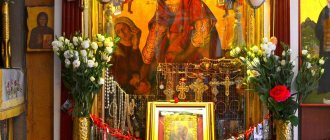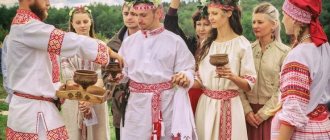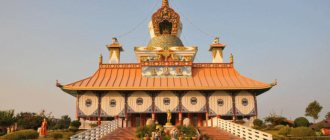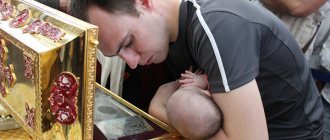"Save me, God!".
Thank you for visiting our website, before you start studying the information, please subscribe to our Orthodox community on Instagram, Lord, Save and Preserve † - https://www.instagram.com/spasi.gospodi/. The community has more than 60,000 subscribers. There are many of us like-minded people and we are growing quickly, we post prayers, sayings of saints, prayer requests, and timely post useful information about holidays and Orthodox events... Subscribe. Guardian Angel to you!
Orthodox monasteries in Russia are not just a list of church buildings, they are a treasure trove of architectural shrines, Orthodox relics, each of which is carefully preserved as a historical monument, as a great heritage for posterity, as the most sacred thing that every Christian has. And what is characteristic is that everyone is active, which means that faith lives and will live in the hearts of people forever.
Solovetsky Monastery
Article: Solovetsky Monastery - a powerful fortress on the Solovetsky Islands of Russia
View of the Solovetsky Monastery
Solovetsky Monastery is an independent monastery of the Russian Orthodox Church. It is located in the White Sea on the Solovetsky Islands. The foundation of the monastery dates back to the 40s of the 15th century, when the Monk Zosima and his friend chose Bolshoi Solovetsky Island as their place of residence. He made such a choice not by chance - the monk saw a church of unprecedented beauty.
Recognizing his dream as a sign from above, Zosima began building a wooden temple with a chapel and a refectory. With its construction he honored the Transfiguration of the Lord. After a short period of time, Zosima and German built a church. With the appearance of these two buildings, which later became the main ones, the arrangement of the monastery territory began. Subsequently, the Archbishop of Novgorod issued a document to the monastery confirming its eternal ownership of the Solovetsky Islands.
How to become a monk
At the moment, there are many monasteries in Russia where new novices are accepted. But it's not as simple as it might seem in reality. Before you enter the monastery, you will have to go through something of a probationary period to prove your good intentions (both to the abbot of the monastery and to yourself). It implies the following:
- Regular visits to the temple. You must regularly attend services, confess, receive communion, and observe all fasts. It is also important to talk with the priest about your intention.
- Staying in a monastery as a worker. The monks not only pray, but also work in the monastery. This is hard physical work. As a rule, workers stay in the monastery for two to three weeks a year.
- Promotion to novices. If after being a laborer you have not changed your intentions, then you must write a petition to become a novice. At the same time, you will bear a worldly name.
- Taking monastic vows. Those who have passed the probationary period become monks and begin to live in the monastery, spending time working and praying.
Please note that people over 30 years of age are more readily accepted as monks. Reasons for refusal may include the presence of dependents, large debts, as well as recent severe stress.
Holy Vvedenskaya Optina Hermitage
Article: Holy Vvedenskaya Optina Hermitage - repository of the relics of the holy elders
View of the Holy Gates of the Holy Vvedenskaya Optina Hermitage
The Holy Vvedenskaya Optina Hermitage is a stauropegial monastery, the servants of which are male monks. Its creator was the robber Opta, or Optia, who at the end of the 14th century. repented of his actions and accepted monasticism. As a clergyman he was known under the name Macarius. In 1821, a monastery was established at the monastery. It was inhabited by the so-called hermits - these are people who spent many years in complete solitude. The mentor of the monastery was the “elder”. Over time, Optina Pustyn turned into one of the leading spiritual centers. Thanks to numerous donations, its territory was replenished with new stone buildings, a mill and land. Today the monastery is considered a historical monument and has a different name - “Museum of Optina Pustyn”. In 1987, it was included in the list of objects of the Russian Orthodox Church.
Kizhi
The monument to Russian wooden architecture is included in the UNESCO World Heritage List. The temple ensemble with 22 chapters is admirable.
Temple complex in Kizhi
The Church of the Transfiguration of the Lord was built at the beginning of the 18th century. The Intercession Church was built in 1694. There is a bell tower.
On the island of Kizhi, located on Lake Onega, there is not just one temple, but a whole museum-reserve. It is better to learn about the holy corner of the land of Karelia during an excursion. I wonder how the restoration went. All buildings were built without a single nail. The craftsmen masterfully replaced the logs.
Novodevichy Convent
Article: Novodevichy Convent - the oldest Orthodox monastery for women
View of the Novodevichy Convent from Novodevichy Ponds Park
The Novodevichy Convent, built in the 16th century, was at that time located on Samsonov Meadow. Nowadays this area is called the Maiden Field. The cathedral church at the monastery was built in the likeness of the Assumption Cathedral - the “neighbor” of the Moscow Kremlin. The monastery walls and towers were built in the 16th – 17th centuries. In general, the architecture of the monastery conveys the “Moscow Baroque” style. The monastery owes its fame to the Godunov family. Boris Godunov lived here before his election as king with his sister Irina. Irina Godunova took monastic vows with the name Alexander and lived in separate chambers with a wooden tower. At the end of the 16th century. The territory of the monastery was replenished with stone walls and a dozen towers. In appearance, they resembled Kremlin buildings (there were square towers in the walls, and round ones in the corners). Their upper parts were decorated with teeth. Today the Novodevichy Convent combines both a museum and a monastery.
Kirillo-Belozersky Monastery
Article: Kirillo-Belozersky Monastery: beauty and grandeur, history and facts
View of the Kirillo-Belozersky Monastery from the Russian North National Park
The Kirillo-Belozersky Monastery is located on the shores of Lake Siverskoye. It owes its appearance to St. Cyril, who founded it in 1397. Construction began with the arrangement of a cell-cave and the installation of a wooden cross over it. In the same year, the illumination of the first shrine took place - it was a wooden church built in the name of the Dormition of the Blessed Virgin Mary. By 1427, there were about 50 monks in the monastery. In the first half of the 16th century. a new life begins at the monastery - all Moscow nobles and kings began to regularly come to it on pilgrimage. Thanks to their rich donations, the monks quickly built up the monastery with stone buildings. Its main attraction is the Assumption Cathedral. Appearing in 1497, it became the first stone building in the North. The monastery complex underwent various architectural changes until 1761.
Valaam Monastery
Article: Spaso-Preobrazhensky Valaam Monastery - a special monastery of the Russian land
General view of the Valaam Monastery
The Valaam Monastery is a stauropegic institution of the Russian Orthodox Church, which occupied the islands of the Valaam archipelago (Karelia). The first mentions of it are found in chronicles of the 14th century. Thus, “The Legend of the Valaam Monastery” informs about the date of its foundation - 1407. Within a couple of centuries, 600 souls of monks lived in the monastery, however, due to repeated invasions by Swedish troops, the island began to decline.
After another 100 years, the territory of the monastery began to be filled with cell buildings and auxiliary premises. But the main buildings of the monastery courtyard were the Assumption Church and the Transfiguration Cathedral. Wanting to create the New Jerusalem from their own monastery, the Valaam ascetics used the names of the New Testament period when arranging its sites. Over the years of its existence, the monastery has undergone many changes, and to this day it remains one of the attractive historical monuments of Russia.
Alexander Nevsky Lavra
Article: Alexander Nevsky Lavra - an architectural complex built in memory of the Great Victory in the Battle of the Neva
General view of the buildings of the Alexander Nevsky Lavra
The Alexander Nevsky Lavra was founded in 1710 at the junction of the Monastyrka River with the Neva. The decision to build it was made by Peter I himself, who wished to perpetuate the victory over the Swedes in 1240 and 1704 in this area. In the 13th century. Alexander Nevsky fought against hordes of Swedes, so he was subsequently canonized for good deeds before the Fatherland. The monastery built in his honor was popularly called the Alexander Temple, and with its construction the expansion of the territory of the Holy Trinity Alexander Nevsky Monastery, or Lavra, began. It is noteworthy that the monastery buildings were located “at rest”, i.e. in the shape of the letter “P” and were decorated with churches in the corners. The landscaping of the yard consisted of a garden with a flower bed. The main holiday of the Lavra is the day of September 12 - it was on this date, back in 1724, that the holy relics of Alexander Nevsky were transferred.
Trinity-Sergius Lavra
Article: Trinity-Sergius Lavra - the largest center of Russian Orthodoxy, culture and spirituality
View of the Trinity-Sergius Lavra
The Trinity-Sergius Lavra was founded in the first half of the 14th century. Venerable Sergius of Radonezh, the son of an impoverished nobleman. According to the clergyman’s plan, the monastery courtyard was arranged in the form of a quadrangle, in the center of which the wooden Trinity Cathedral rose above the cells. The monastery was fenced with a wooden fence. Above the gate there was a small church honoring St. Dmitry Solunsky. Later, all other monasteries adopted this architectural plan, which confirmed the opinion that Sergius was “the head and teacher of all monasteries in Rus'.” Over time, the Holy Spirit Church appeared near the Trinity Cathedral, the building of which combined a temple and a bell tower (“like the bells”). Since 1744, the majestic monastery was renamed Lavra.
Xin is a stone
This stone is located right on Lake Pleshcheyevo. According to legend, a spirit lives in it, which gives strength and health. Every tourist wants to break off a piece from this famous boulder in order to absorb its energy. However, this is strictly monitored and they are only allowed to sit next to the stone and express all their pain to it. They believe that the stone will take all sorrows upon itself.
Russia is a borderless country. We have many holy places imbued with miraculous power. The main thing is to believe in the power of nature, prayer and God's help. And also be grateful for what you have and for what you want to have, as if you already have it!
Spaso-Preobrazhensky Monastery
Article: Seraphim-Diveevo Monastery - the fourth earthly inheritance of the Mother of God
View of the cathedrals of the Spaso-Preobrazhensky Monastery
Spaso-Preobrazhensky Monastery is a monastic monastery in Murom, founded by the passion-bearer prince Gleb. Having received the city as an inheritance, he did not want to settle among the pagans, so he decided to establish a princely court above the Oka. Having chosen a suitable place, Gleb of Murom built his first temple on it - this is how he immortalized the name of the All-Merciful Savior. Later he added a monastic monastery to it (the premises were used to educate the Murom people). According to the chronicle, the “monastery of the Savior on the forest” appeared in 1096. Since then, many clergy and miracle workers have visited its walls. Over time, the Spassky Cathedral appeared on the territory of the monastery - through its construction, Ivan the Terrible immortalized the date of the capture of Kazan. To furnish the premises of the new temple, the tsar allocated icons, church utensils and literature, and clothing for ministers. The Church of the Intercession with chambers, a bakery, a flour shed and a cookhouse was built in the second half of the 17th century.
Solovki
The Solovetsky Archipelago is the name of this place located in the Arkhangelsk region. There is the Holy Lake and Mount Golgotha - this is the highest mountain of all Solovki. People come here more to relax their souls. The island has many ancient buildings and simply beautiful natural places.
There is a beautiful view here that can heal a person from any mental torment or bad misfortunes. This is a mystical and at the same time mysterious place that has a special energy: here you can see such mysterious ancient structures as dolmens, mounds and labyrinths of stones.
Seraphim-Diveevo Monastery
Article: Seraphim-Diveevo Monastery - the fourth earthly inheritance of the Mother of God
View of the Seraphim-Diveevsky Monastery
Seraphim-Diveevo Monastery is a convent founded in the 2nd half of the 18th century. At Mother Alexandra's own expense, the foundation of the Kazan Church was first laid. Pachomius, a master famous for the construction of the Sarov Desert, was in charge of its consecration as construction was completed. The church premises were equipped with 2 chapels - in the name of Archdeacon Stephen and St. Nicholas. Then the Trinity and Transfiguration Cathedrals appeared in Diveevo. The latter was built with substantial donations, because reinforced concrete was used in its construction for the first time (previously such material had not been used in the construction of shrines). But the main temple here is considered to be the Trinity Cathedral, in which the relics of Seraphim of Sarov rest. Everyone who wants to receive grace-filled help and healing specially gathers at the shrine with the relics of the monk.
Athos monasteries
On Mount Athos, a skete is a separate monastic settlement subordinate to a monastery. Usually such a village consists of kalivas.
Interesting to know! Kaliva on Mount Athos is the name of the hut in which the monks live. Most often, three to six monks live in it. Each kaliva is considered a separate unit and lives according to its own schedule. Several kalivas located together form a monastery.
In addition, on Mount Athos there is such a thing as communal monasteries. In fact, they are absolutely no different from ordinary monasteries, except that they are subordinate to one of the monasteries.
Pskov-Pechersky Monastery
Article: Holy Dormition Pskov-Pechersky Monastery - the northwestern frontier of Orthodoxy
View of the buildings of the Pskov-Pechersky Monastery
The Pskov-Pechersky Monastery was founded in 1473, when the consecration of the Assumption Church, dug out of a sandy hill by the Monk Jonah, took place (it was located near the Kamenets stream). During the first 500 years of its existence, the monastery experienced many different bad events, and only under Abbot Dorotheos did it experience a period of prosperity. Already in the 20s of the 16th century. The Church of the Assumption was improved and expanded, and other churches and buildings for various purposes appeared. The construction work was managed by the sovereign clerk Misyur Munekhin. He spared no expense in establishing the monastery, which is why after his death he was buried in a cave at the monastery (previously the laity had not been buried here). The next period of prosperity of the monastery occurred during the years of Abbot Cornelius' service there. Under him, the monastery became famous as never before. Thanks to the funds of pilgrims who flocked to the courtyard in streams, the once wretched monastery was replenished with land, estates and precious deposits.
| ← RUSSIA | EUROPE → |









